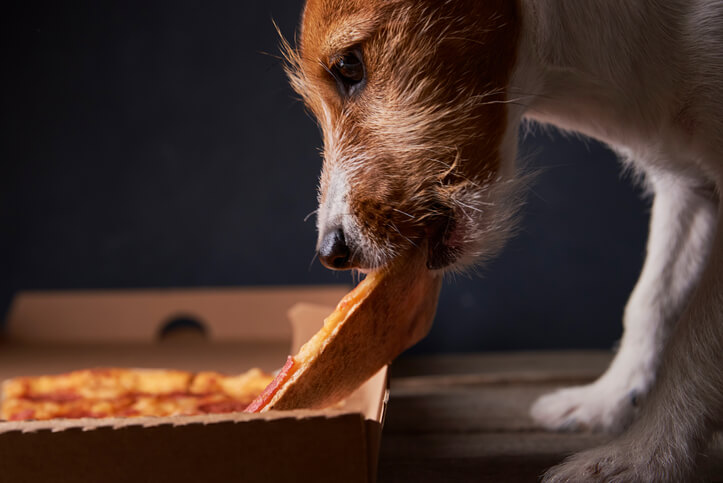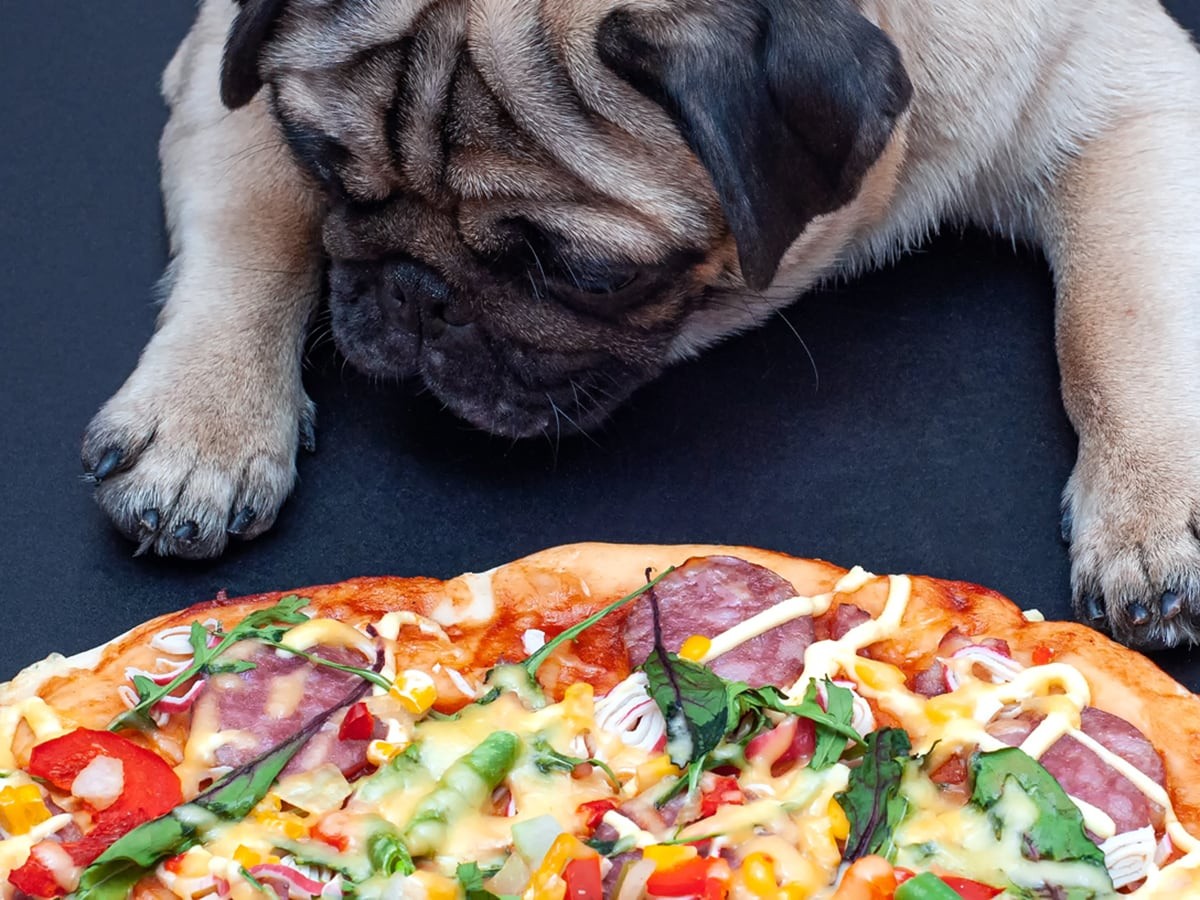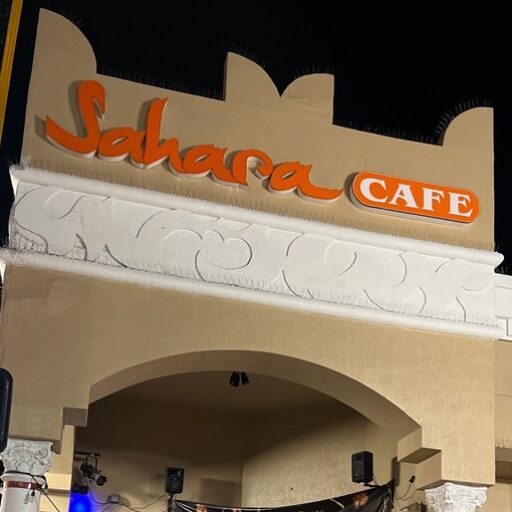Introduction
What Is The Controversy Around Feeding Pizza To Dogs?
Feeding pizza to dogs has been a topic of debate among pet owners and experts. While some people believe that sharing a slice of pizza with their furry friend is harmless, others argue that it can be potentially dangerous for dogs.
One of the main concerns is the toppings and ingredients found in pizza. Many pizzas contain ingredients that are toxic to dogs, such as onions, garlic, and certain types of cheese. These ingredients can lead to gastrointestinal issues, vomiting, and even more serious health problems. Additionally, the high fat and sodium content in pizza can also be harmful to a dog’s overall health, leading to obesity and heart issues.
The Importance Of Understanding The Risks Involved
It is crucial for dog owners to understand the risks involved in feeding pizza to their pets. While it may seem harmless, even a small amount of certain ingredients can have detrimental effects on a dog’s health. It is also important to note that each dog may react differently to different foods, so what may be safe for one dog may not be safe for another.
To avoid any potential health issues, it is best to stick to a balanced and complete diet specially formulated for dogs. If you want to treat your dog, there are plenty of safe alternatives available, such as homemade dog treats or commercially available dog-friendly snacks. Always consult with your veterinarian before introducing any new foods into your pet’s diet, as they can provide guidance based on your dog’s individual needs.
In conclusion, while it may be tempting to share pizza with your furry friend, it is best to prioritize their health and well-being. Understanding the potential risks involved in feeding pizza to dogs can help you make informed decisions regarding their diet.
Digestive System Of Dogs
How Dogs Digest Food
Dogs have a complex digestive system that allows them to break down and absorb nutrients from their food. The process starts in the mouth, where saliva begins the digestion of carbohydrates. From there, the food travels to the stomach, where it is mixed with gastric acids and digestive enzymes to break down proteins and fats. The partially digested food then moves into the small intestine, where further digestion and nutrient absorption occur. Finally, the waste products are eliminated through the large intestine and rectum.
The Impact Of Pizza On A Dog’s Digestive System
Feeding pizza to dogs can disrupt their digestive system and lead to various health issues. The ingredients found in pizza, such as onions, garlic, and certain types of cheese, can be toxic to dogs and cause gastrointestinal problems. The high fat content in pizza can also lead to pancreatitis, a painful condition that affects the pancreas. Additionally, the excessive sodium in pizza can dehydrate dogs and put strain on their kidneys.
Even if a dog does not immediately show signs of distress after eating pizza, the long-term impact on their digestive system can be detrimental. It is important to prioritize a balanced and complete diet for dogs that is specially formulated to meet their nutritional needs.

Ingredients In Pizza That Are Harmful To Dogs
Identifying Ingredients That Can Be Toxic To Dogs
Dogs have a highly sensitive digestive system, and certain ingredients commonly found in pizzas can be harmful to them. It is essential for dog owners to be aware of these ingredients and avoid feeding pizza to their furry companions. Some of the ingredients that are toxic to dogs include:
- Onions and garlic: These vegetables contain compounds that can damage a dog’s red blood cells, leading to anemia.
- Cheese: While small amounts of cheese may be safe for dogs, certain types of cheese, such as blue cheese, can cause adverse reactions due to their high fat content.
- Seasonings: Pizzas are often flavored with spices like garlic powder and oregano, which can be detrimental to a dog’s health.
The Dangers Of Certain Toppings And Seasonings
Apart from the main ingredients, it is important to consider the specific toppings and seasonings that can be harmful to dogs:
- Pepperoni and other cured meats: These meats are high in sodium and fat, which can lead to pancreatitis and digestive disturbances in dogs.
- Spicy toppings: Dogs have more delicate taste buds than humans and may find spicy toppings like peppers or chili flakes to be irritating and uncomfortable.
To keep your dog’s digestive system healthy, it’s best to avoid feeding them pizza altogether. Opting for a balanced and specifically formulated diet for dogs will ensure their nutritional needs are met without any potential harm.
Health Risks Associated With Feeding Pizza To Dogs
Obesity And Weight Gain
Feeding pizza to dogs on a regular basis can contribute to obesity and weight gain, just like with humans. Pizza is high in calories, fat, and sodium, which are all factors that can lead to excessive weight gain in dogs. Obesity in dogs can lead to a range of health issues, including joint problems, diabetes, and heart disease.
Pancreatitis And Gastrointestinal Upset
Pizza toppings such as cured meats like pepperoni are high in fat and sodium. Feeding these fatty foods to dogs can put a strain on their pancreas, potentially leading to pancreatitis. Pancreatitis is an inflammation of the pancreas that causes digestive upset, abdominal pain, and in severe cases, can be life-threatening. Even non-fatty toppings like spicy peppers or seasonings can irritate a dog’s gastrointestinal system, causing discomfort, vomiting, and diarrhea.
It is crucial for dog owners to prioritize their pet’s health by providing them with a balanced and appropriate diet that meets their nutritional needs. Feeding them pizza, even as an occasional treat, can introduce unnecessary health risks. Consult with a veterinarian to ensure your dog’s diet is suitable and provides all the necessary nutrients.
Specific Health Concerns And Pizza
Increased Sodium Intake And Its Effects
Feeding pizza to dogs can result in an increased intake of sodium, which can have adverse effects on their health. Excessive sodium consumption can lead to dehydration and may also cause an increase in blood pressure, putting strain on the cardiovascular system. Dogs with pre-existing health conditions such as heart disease or kidney problems are especially vulnerable to the negative effects of high sodium intake.
The Risks Of Cheese And Lactose Intolerance In Dogs
Cheese is a common ingredient in pizza and can be problematic for dogs. Many dogs are lactose intolerant, meaning they lack the necessary enzymes to properly break down lactose, the sugar found in dairy products. Feeding cheese to lactose intolerant dogs can result in digestive upset, including diarrhea and abdominal discomfort. Additionally, cheese is high in fat and can contribute to weight gain and obesity in dogs.
It is important for dog owners to be aware of the specific health risks associated with feeding pizza to their furry friends. While pizza may be a tempting treat, it is crucial to prioritize their overall well-being and provide them with a balanced and appropriate diet that meets their nutritional needs. Consulting with a veterinarian can help ensure that your dog’s diet is suitable and reduces the risk of any health complications.

Table Scraps: Why Pizza Should Be Avoided
The Dangers Of Feeding Table Scraps To Dogs
Feeding pizza to dogs may seem harmless, but it can have serious health implications. Here are a few reasons why pizza should be avoided as a treat for your furry friend:
- Increased sodium intake: Pizza contains high levels of sodium, which can lead to dehydration and elevated blood pressure in dogs. This can put strain on their cardiovascular system, especially for dogs with pre-existing heart conditions or kidney problems.
- Cheese and lactose intolerance: Cheese, a common ingredient in pizza, can be problematic for dogs. Many dogs are lactose intolerant, meaning they lack the necessary enzymes to break down lactose, leading to digestive upset and discomfort. Additionally, cheese is high in fat and can contribute to weight gain and obesity in dogs.
The Long-term Health Implications
Feeding pizza to dogs regularly can have long-term consequences on their overall health:
- Weight gain and obesity: Pizza, with its high fat and calorie content, can lead to weight gain and obesity in dogs. This can increase the risk of other health issues, such as joint problems and diabetes.
- Nutritional imbalance: Pizza lacks the essential nutrients that dogs need to thrive. Feeding it as a regular part of their diet can result in nutritional deficiencies and imbalances, impacting their overall wellbeing.
To ensure the wellbeing of your furry friend, it is best to avoid feeding pizza or any table scraps to dogs. Stick to a balanced and appropriate diet recommended by a veterinarian to meet their specific nutritional needs.
Alternatives To Feeding Pizza To Dogs
Healthy And Safe Food Options For Dogs
Feeding dogs a balanced and nutritious diet is crucial for their overall health and wellbeing. Instead of feeding them pizza, consider the following alternatives:
- Lean meats: Cooked lean meats like chicken, turkey, or beef can be a great source of protein for dogs. Make sure to remove any bones, seasoning, or skin before feeding.
- Fruits and vegetables: Many fruits and vegetables can be safe and healthy treats for dogs. Some options include carrots, blueberries, apples (without seeds), and green beans.
- Grains and starches: Cooked rice, oatmeal, or quinoa can provide dogs with carbohydrates and energy. Make sure to keep these foods plain and free from any added ingredients or seasonings.
DIY Dog-friendly Pizza Recipes
If you want to treat your dog to a pizza-like snack, there are DIY recipes that are safe and healthy:
| Ingredients | Instructions |
|---|---|
| Whole wheat flour | Mix with water to form a dough |
| Chicken or turkey | Cook and shred the meat |
| Carrots, spinach, or other dog-friendly veggies | Chop and lightly steam or cook |
| Low-sodium tomato sauce | Spread a thin layer on the dough |
| Low-fat cheese (in moderation) | Sprinkle a small amount over the sauce |
| Bake at 350°F for 15-20 minutes | Monitor closely to prevent burning |
Remember, it’s important to consult with your veterinarian before making any significant changes to your dog’s diet. They can provide tailored advice and ensure your furry friend is receiving the right nutrients for their specific needs.
Signs Of Pizza Toxicity In Dogs
Recognizing Symptoms Of Pizza-related Illness In Dogs
Feeding dogs pizza can lead to various health issues and toxicity due to the ingredients used in pizza. It’s important to be aware of the signs of pizza toxicity in dogs, which may include:
- Vomiting and diarrhea: Dogs may experience these symptoms due to the high fat content, seasonings, or ingredients like onions and garlic that can be toxic to them.
- Abdominal pain: Dogs may show signs of discomfort or abdominal pain after consuming pizza. They might display restlessness, pacing, or whimpering.
- Lethargy and weakness: The high sodium content in pizzas can cause dehydration in dogs, leading to lethargy and weakness.
- Increased thirst and urination: If a dog consumes a lot of pizza, it may experience excessive thirst and urination due to the high sodium content.
Knowing When To Seek Veterinary Assistance
If your dog exhibits any of these signs after consuming pizza, it is important to seek veterinary assistance promptly. Contact your veterinarian if:
- Your dog ingests pizza containing toxic ingredients like onions, garlic, or mushrooms.
- The symptoms persist for more than 24 hours.
- Your dog has underlying health conditions that may be worsened by pizza consumption.
Remember, prevention is always better than cure. Avoid feeding your dog pizza and opt for healthier alternatives to ensure their wellbeing and longevity.
Signs Of Pizza Toxicity In Dogs
Recognizing Symptoms Of Pizza-related Illness In Dogs
Dogs can experience various health issues and toxicity from consuming pizza due to its ingredients. It’s crucial for dog owners to be able to recognize the signs of pizza toxicity in their pets. Some common symptoms may include:
- Vomiting and diarrhea: These symptoms can occur due to the high fat content, seasonings, or the presence of toxic ingredients like onions and garlic.
- Abdominal pain: Restlessness, pacing, or whimpering may indicate abdominal discomfort or pain after consuming pizza.
- Lethargy and weakness: Pizza’s high sodium content can lead to dehydration, resulting in lethargy and weakness.
- Increased thirst and urination: Excessive ingestion of pizza can cause dogs to experience heightened thirst and urination due to the high sodium levels.
Knowing When To Seek Veterinary Assistance
If a dog displays any of these signs after eating pizza, it is important to promptly seek veterinary assistance. Contact a veterinarian if:
- Your dog has ingested pizza containing toxic ingredients such as onions, garlic, or mushrooms.
- The symptoms persist for more than 24 hours.
- Your dog has underlying health conditions that may be aggravated by pizza consumption.
Prevention is always better than cure. Instead of feeding your dog pizza, opt for healthier alternatives to ensure their well-being and longevity.
Conclusion
The Importance Of Responsible Pet Ownership
As responsible pet owners, it is crucial for us to prioritize our dogs’ health and well-being. Understanding the potential risks associated with feeding them certain foods, such as pizza, helps us make informed choices.
Tips For Keeping Dogs Safe And Healthy When It Comes To Food Consumption
To ensure our dogs stay safe and healthy when it comes to food consumption, it’s important to:
- Consult with a veterinarian about their dietary needs and any potential food allergies.
- Avoid feeding them foods that contain toxic ingredients like onions, garlic, or mushrooms.
- Provide them with a balanced diet that includes high-quality dog food and appropriate treats.
- Supervise their eating habits to prevent them from consuming harmful substances or choking hazards.
By following these tips, we can help to minimize the risk of food-related illnesses and keep our furry friends happy and healthy.
FAQ: Is Pizza Bad for Dogs: Understanding the Risks of Feeding Pizza to Dogs
1. Can dogs eat pizza?
While dogs can technically eat pizza, it is generally not recommended to feed them this food because it can be harmful to their health.
2. What are the risks of feeding pizza to dogs?
There are several risks associated with feeding pizza to dogs. Firstly, pizza dough contains yeast, which can ferment in a dog’s stomach and lead to painful bloating or even life-threatening conditions like gastric dilation and volvulus (GDV). Secondly, the ingredients commonly found in pizza, such as cheese, tomato sauce, onions, garlic, and various toppings, can be harmful or toxic to dogs.
3. How can pizza dough harm dogs?
Pizza dough poses a dual risk to dogs. Firstly, the yeast in uncooked dough can ferment and produce alcohol, leading to alcohol poisoning in dogs. Secondly, as the dough rises, it can expand in the dog’s stomach, causing severe bloating, leading to discomfort, vomiting, or potentially Gastric Torsion, a life-threatening condition.
4. Why are pizza ingredients harmful to dogs?
Some ingredients commonly used in pizzas are harmful to dogs. For instance, cheese is difficult for dogs to digest and can cause digestive issues. Tomato sauce can be acidic and cause stomach upset. Onions and garlic, both toxic to dogs, can damage their red blood cells, leading to anemia. Other potential toppings like processed meats may contain harmful preservatives, excessive sodium, or spices that can upset a dog’s digestive system.
5. Are there any dog-friendly alternatives to pizza?
Yes, there are several dog-friendly alternatives to pizza that can be both safe and enjoyable for your furry friend. You can try making homemade dog treats using ingredients like lean meat, carrots, peas, sweet potatoes, or even a small amount of plain cooked pasta. Just make sure to research the ingredients you plan to use for any potential hazards and consult your veterinarian if unsure.
6. What should I do if my dog accidentally eats pizza?
If your dog accidentally eats pizza, it’s important to monitor them for any signs of discomfort or distress. Contact your veterinarian to seek advice if you notice symptoms such as vomiting, diarrhea, abdominal pain, bloating, or changes in behavior. It’s always better to be safe than sorry when it comes to your pet’s health.
In summary, while it may be tempting to share an occasional slice of pizza with your furry companion, it’s important to understand the potential risks involved. Pizza dough, yeast, cheese, tomato sauce, onions, garlic, and various toppings can all cause harm to dogs. To ensure the well-being of your pet, it’s best to avoid feeding them pizza and instead opt for safe, dog-friendly alternatives. Always consult your veterinarian for specific dietary advice for your dog.

Welcome to Sahara Cafe Hollywood, the best Latin food restaurant in Hollywood, Florida! Our journey began with a passion for bringing Latin cuisine’s vibrant flavors to Hollywood’s heart. Located at 2000 Harrison St, Suite 1, Hollywood, FL 33020, United States, Sahara Cafe has become a beloved culinary destination for locals and visitors alike. Since our establishment, Sahara Cafe Hollywood has been dedicated to delivering an authentic and memorable dining experience. Every dish we create reflects our commitment to serving the finest Latin cuisine. From sizzling fajitas to mouthwatering empanadas, each item on our menu is crafted with the freshest ingredients and traditional recipes that capture the essence of Latin American culinary heritage.